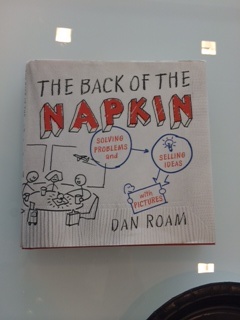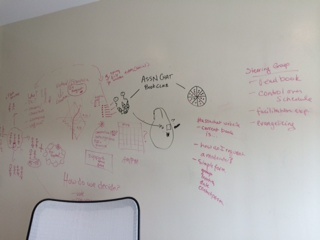
The elusive Association Chat Book Club, (so elusive, only one meeting took place in 2013) was recently revived to discuss The Back of the Napkin.
Author Dan Roam’s book is designed to help business executives brainstorm and communicate visually to solve complex problems. Who hasn’t wanted to be more of a visual thinker? The daunting task of putting finger to keyboard to write out the dreaded business plan or to communicate that plan to a room full of BOD members are some of the common gut-wrenching fears I hear from association executives. Whether facilitating a BOD meeting or brainstorming with your team, here’s a brief overview of Roam’s methodology:
Roam says you should use 4 basic rules when you look at something new:
- Collect all the information you can
- Lay it all out where you can look at it
- Establish fundamental coordinates
- Practice visual triage
Maybe it was because I had recently watched HBO’s True Detective and NBC’s The Blacklist, but Roam’s first 2 rules reminded me of the same methodology a detective takes when looking for connections and visual cues in a crime case – splattering mugshots and additional information up on a board and looking for visual cues to connect the dots. (At least, that’s how they do it on TV!) As humans, we’re naturally great at filtering large chunks of information and finding patterns.
Establish fundamental coordinates as the main categories or measurements you want to assign this information. What’s the information you’re trying to compare? Roam uses “How Much?” and “Where?” and “Who/What?” as his coordinate system. In the business world, we typically organize this information in graphs and charts.

Roam explains that visual triage is the ability to use precognitive cues to quickly understand something before we even realize we’re processing the information. He uses the example of grouping colors, sizes, and distance. If we’re able to group items this way, we can “save our high-level mental capacity for deeper analytic processing.”
The book club tests Roam’s theory
The Association Chat Book Club decided to put Roam’s book to the test. Aside from the book itself, the biggest sub-conversation at the meeting was about what the future state of the Book Club should look like. We started with rules 1 and 2:
We identified our goals, purposes, and strategies for expanding this roving Book Club and aligning it with upcoming association events. Within an hour, we were able begin making decisions. As a result, I would say the book club meeting was the most productive one I’ve ever attended; I plan to use these visual techniques in future brainstorming meetings. How do you use visual techniques in your meetings?
